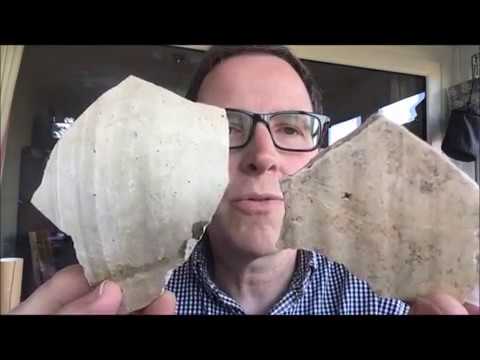Some help with dividing green glazed whiteware sherds into Medieval and Post Medieval.
To see hundreds of other pottery finds, and share your own for ID, join these Facebook groups –
Thames Foreshore Finds –
The River Thames Mudlarking Finds –
and if you like the metal stuff there's loads of that too!
Also check out a pottery only Facebook site for UK finds –


Glad to see you back. More mudlarking too please! 🙂
Thank you, I’m not planning to go mudlarking in the near future, sadly.
Welcome back, Richard. Great video. Please feel free to post it in the groups. Well done and thank you.
Thanks, I have posted it.
Good to see another informative post from you.
How about one on what was used to make the glazes?
Thank you! The glaze suggestion is a good one, to quote from Hedingham Ware, East Anglian Archaeology no. 148 by Helen Walker – A number of possible different lead based starting
materials for making lead glazes existed in the Medieval period, including
galena (lead sulphide), litharge (lead oxide), metallic lead and white lead (a
mixture of lead hydroxide and lead carbonate.) Firing the glaze causes a
reaction between the surface layers of the body and the lead compound, fusing
them into a glass like material, and simultaneous penetration of some of the
molten glaze into the underlying surface of the pot. Where a coloured glaze is
intended it is necessary to introduce a proportion of metallic elements which
will render the glaze coloured, in the Medieval period typically copper, iron
or manganese, often singly but occasionally in combination.
Richard , another great video .. do keep it up please .
Thank you!
Another great video from Richard Hemery! Thank you, Richard. I very much appreciate your work.
Thank you!
Great to see you back. Always interesting topic..
Thank you!
Great video! Thank you! (I like the idea of an entire “The Pottery Doctor will See You Now” series …)
Ha ha, if I had more time!
So glad your back!! Hello from Canada!
Thank you!
You should create more content! Your videos are always educational…And please go mudlarking again! I moved to America from the UK in 1981, so it’s lovely to see you find all the historic items. It’s a miracle if we find anything 50 years old in the states.
Thank you!
Excellent. many mysteries made clear here thankyou . appreciate your non-academic title
Can you say, very generally… how you chose the sites along the Thames to find the pottery sherds, was it where the pottery was made or where it was used and discarded
I liked your analogy, “medieval pottery are full of bits”, but it drove the point home very well so shall not forget. Good to see you back here again though.
Thanks Richard another great educational vid. Waiting for your next gem.
thank you!
Thank you so much Richard, very informative!
Thanks!
Very useful, especially the glaze pits. I must check all shards I have.
You amaze me with your knowledge of pottery!! How do you know what these tiny pieces are??? Just amazing!! Btw…hello from the USA!
Hello, when I started I knew nothing. But by comparing finds in museums, seeking advice, and reading lots of reports, I began to recognise the characteristics of the different industries. Questions such as – what colour is the clay? What does it have in it, anything added? Is it glazed? What shape is the rim? These all help pining down a date. Sometimes there is no narrow dating possible, e.g. Post Medieval Redware can fall anywhere from 1480 – 1950!
I wish you’d start adding new mudlarking content. It’s fascinating!
Thanks, I need to get around to renewing my licence!
Dear Richard, I love your videos and have learnt a lot from them. I wondered if you could help me ID an unusual vase I found in a junk shop please? Im usually a great researcher but this vase truly has me stumped. Apologies if this is impolite or pushy of me.
Not at all, I hope i can help. Maybe you could send me some photos at richardhemery@tiscali.co.uk
Ok Richard. So I get the genre you compared, but how does one tell the pottery of 1800’s bowls and such from the others? Hope you and family are coming thru all lockdown and keeping well. Miss you mudlarkers😕🌝
Learned a lot from the video…thank you 👍💕